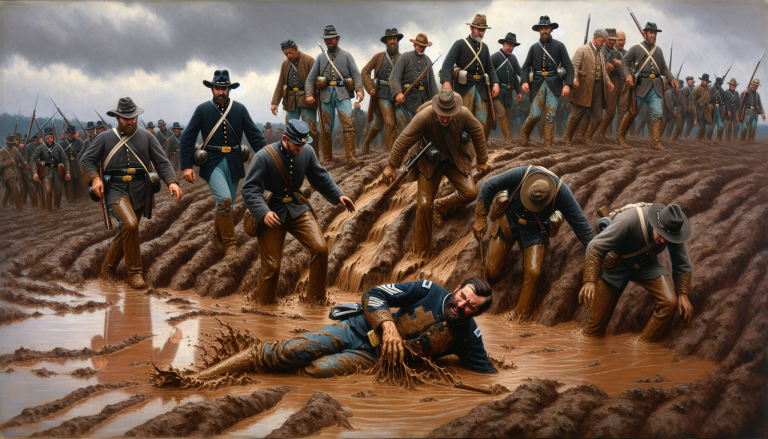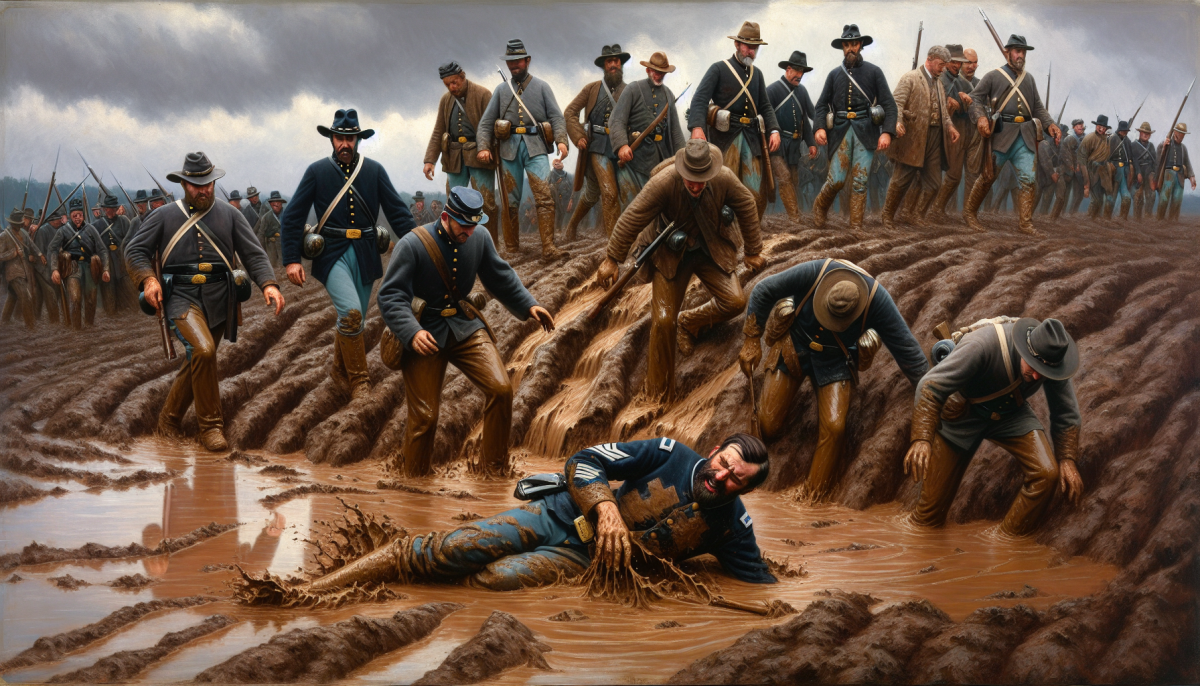Flogging a Forgotten Folly: The Hapless Saga of General Ambrose Burnside and the Mud March

In the annals of military history, few endeavors have achieved the level of futility and comical ineptitude as the infamous “Mud March” led by the hapless General Ambrose Burnside during the American Civil War. This spectacle of a campaign, which took place in January 1863, stands as a prime example of “beating a dead horse” – a futile effort that defied all logic and reason.
General Burnside, known for his distinctive sideburns that would later bear his name, had recently taken over command of the Army of the Potomac from the much-maligned General George McClellan. Eager to prove his mettle and deliver a decisive blow against the Confederate forces, Burnside hatched a plan that, on paper, seemed bold and promising. However, as history would cruelly demonstrate, the Mud March was destined to become a textbook case of a blunder for the ages.
The plan was simple: Burnside would lead his troops on a flanking maneuver around the Confederate forces, cutting off their supply lines and potentially forcing a decisive engagement. With the winter weather on their side, Burnside believed that the soft, muddy terrain would hinder the Confederates’ ability to respond effectively.
A Muddy Misadventure
As the Union troops set out on their grand maneuver, the skies opened up, unleashing a torrential downpour that turned the landscape into a veritable quagmire. The soldiers struggled to trudge through the thick, clinging mud, their boots and equipment becoming hopelessly bogged down with each agonizing step. Supply lines ground to a halt, and the troops quickly became exhausted, demoralized, and woefully ill-equipped to continue the advance.
Despite the obvious futility of the endeavor, Burnside stubbornly pressed on, refusing to acknowledge the growing disaster unfolding before his eyes. His subordinate officers, sensing the impending calamity, pleaded with him to call off the operation, but the general’s pride and unwavering determination proved to be his undoing.
As the Mud March dragged on, the Union troops found themselves mired in a literal and figurative quagmire. Horses and mules sank deep into the mud, rendering them unable to pull the heavy artillery and supply wagons. Soldiers, their boots caked in thick, clinging mud, struggled to maintain their footing, often collapsing from sheer exhaustion.
A Farcical Finale
The culmination of this disastrous campaign came when Burnside, in a desperate attempt to salvage the situation, ordered his troops to construct a pontoon bridge across the Rappahannock River. This Herculean task, which would have been challenging even under the best of conditions, proved to be a cruel joke in the face of the relentless mud.
As the soldiers labored to haul the heavy pontoons through the muck, the bridge repeatedly collapsed, leaving the troops stranded and exposed to the elements. Burnside’s frustration mounted, and in a fit of pique, he ordered his subordinates to “beat a dead horse” – a futile effort that perfectly encapsulated the entire Mud March debacle.
The once-proud Union army had been reduced to a bedraggled, demoralized mob, their morale and fighting spirit sapped by the seemingly endless battle against the unyielding mud. Burnside, realizing the folly of his actions, finally called off the operation, but not before the damage had been done.
The Aftermath and Legacy of the Mud March
The Mud March was a resounding failure, a testament to the dangers of stubbornness and the perils of underestimating the power of nature. Burnside’s career was irreparably damaged, and he was eventually relieved of his command, with General Joseph Hooker taking over the reins of the Army of the Potomac.
The phrase “beating a dead horse” has since become synonymous with the Mud March, a cautionary tale of the futility of persisting in a lost cause. Historians and military strategists alike have pored over the details of this debacle, using it as a cautionary example of the importance of adaptability, strategic foresight, and the willingness to admit defeat when the situation becomes untenable.
Indeed, the Mud March stands as a testament to the enduring power of satire and humor in the annals of history. Countless cartoons, articles, and jests have been crafted around this farcical episode, with writers and artists reveling in the sheer absurdity of Burnside’s ill-fated campaign.
As we look back on the Mud March, we are reminded that even the grandest of military plans can be undone by the simplest of obstacles – in this case, a little mud and a whole lot of stubborn determination. It is a lesson that echoes across the centuries, a cautionary tale that serves as a reminder to always be prepared for the unexpected, and to know when to cut one’s losses and admit defeat.
